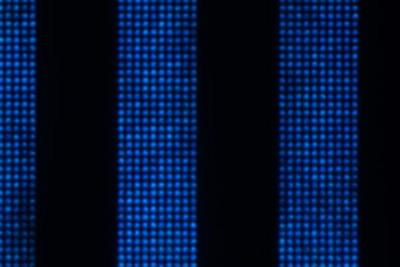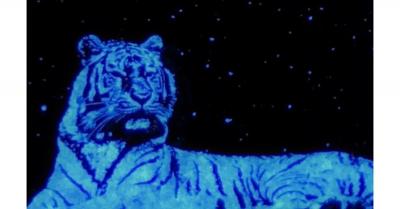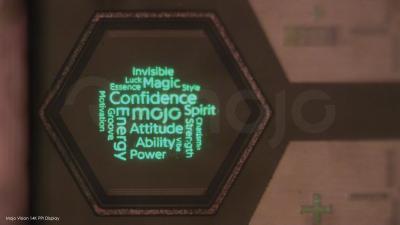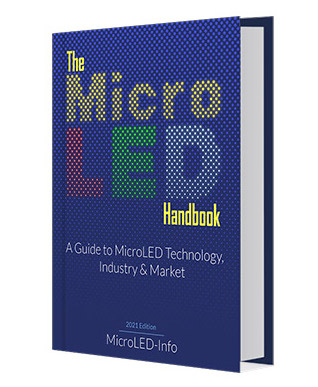This article is an extract from The MicroLED Handbook, 2020 edition, and gives a short introduction to the current market status of MicroLED Microdisplays. The handbook was published in January 2020 - there has been some updates since then, for example Plessey's recent soft-acquisition by Facebook and MICLEDI's technology was revealed.
There are several companies that develop microLED microdisplays, and these are gearing up to begin mass production of displays soon. It is likely that microdisplays will be the first type of commercial displays enabled by microLED technology.
Plessey Semiconductor
UK-based Plessey Semiconductors developed its own microLED production process and based on that process the company created two display product families. The first is a segmented microdisplay platform which they call Direct-Drive. Such displays can be used in applications that require high brightness, low power - and a simple display that is not dot-matrix but segmented.
Plesseyâs more advanced product is an active-matrix display with a CMOS backplane. The company has demonstrated a 0.7-inch monochrome blue display with a CMOS backplane made by Jasper Display. In October 2019 Plessey entered into a partnership with microdisplay system developer Compound Photonics to co-develop a Full-HD (1920x1080) 0.26-inch microLED display solution, which is around 8400 PPI.
Plessey says that growing their microLEDs on silicon (as opposed to sapphire substrates) allows them to maintain a high efficiency even at very small pixel size. Using silicon also makes it easier to scale to larger wafers, which will help reduce cost in the long term.
 Plessey blue 2.5-micron LED array
Plessey blue 2.5-micron LED array
Plessey did not yet disclose its roadmap for actual microdisplay production â and whether it aims to produce in-house or use a fab partner.
Lumiode
US-based Lumiode has developed a truly monolithic microLED microdisplay technology that enables the deposition of LTPS TFTs directly on microLED wafers. The company says that this creates a cost-effective process that makes for extremely bright and efficient microdisplays.
![]() Lumiode pixel structure
Lumiode pixel structure
Lumiodeâs main tech is the TFT deposition process and the company has an in-house production tool that uses 3rd-party epiwafers. Lumiode is a fabless company which plans to outsource all production steps. The company aims to start producing and marketing monochrome high brightness microdisplays in the near future.
VueReal
Canadian microLED developer VueReal has developed a technology for self-aligned microLED printing-based production, which enables the company to produce high-density displays â up to 30,000 PPI (!). In 2018, VueReal raised $8.5 million to build an advanced pilot fabrication center in Waterloo, Canada.

In 2019, the company said it will soon start sampling microLED microdisplays.
Jade Bird Display (JBD)
Shanghai-based JBD, established in 2015, develops microLED based microdisplays. The company is currently producing and selling VGA monochrome (red, green or blue) microLED microdisplays in its own pilot production line.
In 2019, JBD demonstrated high-pixel density (5,000 and 10,000 PPI) microdisplays, the 5,000 PPI one with a very high brightness of 2 million nits.
Other microLED microdisplay makers
In addition to the abovementioned companies, there are other companies that develop microLED microdisplays worth mentioning. Korea-based Lumens is collaborating with the Korean Institute of Machinery & Materials, and in early 2019 demonstrated a Full-HD (1920x1080) monochrome (green) microdisplay. The company also showed a 720p microdisplay that offers a brightness of up to 100,000 units and a lifetime of 50,000 hours.

High-profile AR developer Mojo Vision (who raised over $100 million from HP, LG, Google and others) is developing its own microLED technology. The company hasnât disclosed much yet, but it did announce that it developed a 14,000 sub-pixel PPI monochrome green microLED microdisplay. It is likely that the company will seek to produce its displays at an external foundry.
This was an extract from The MicroLED Handbook, 2020 edition. The book gives an introduction to MicroLED displays, the technology, industry and market.
 Reading this book, you'll learn all about:
Reading this book, you'll learn all about:
- MicroLED technology, materials and production processes
- How MicroLEDs compare to LCDs and OLEDs
- What are the challenges towards commercial production
- LED technology and manufacturing processes
- MicroLED driving and full-color architectures
- The MicroLED displays currently on the market
The MicroLED book also provides:
- An in-depth guide to MicroLED Microdisplays
- Potential applications of MicroLED displays
- A comprehensive list of MicroLED companies
- An introduction to other emerging display technologies (such as quantum dots and OLEDs)
- A current overview of the MicroLED market
- Market and industry forecasts
- And much more!

